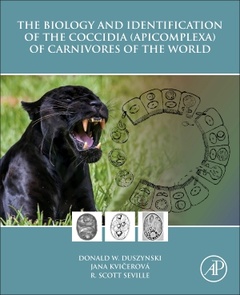The Biology and Identification of the Coccidia (Apicomplexa) of Carnivores of the World
Auteurs : Duszynski Donald W., Kvičerová Jana, Seville R. Scott

The fundamental concept of The Biology and Identification of the Coccidia (Apicomplexa) of Carnivores of the World is to provide an up-to-date reference guide to the identification, taxonomy, and known biology of apicomplexan intestinal and tissue parasites of carnivores including, but not limited to, geographic distribution, prevalence, sporulation, prepatent and patent periods, site(s) of infection in the definitive and (if known) intermediate hosts, endogenous development, cross-transmission, pathology, phylogeny, and (if known) their treatments. These data will allow easy parasite recognition with a summation of virtually everything now known about the biology of each parasite species covered. The last (very modest) and only treatise published on this subject was in 1981 so this book fills a fundamental gap in our knowledge of what is now known, and what is not, about the coccidian parasites that infect and sometimes kill carnivores and/or their prey that can harbor intermediate stages, including many domestic and game animals.
1. Introduction2. Review Carnivore Evolution3. Eimeriidae in the Caniformia Family Ailuridae4. Eimeriidae in the Caniformia Family Canidae5. Eimeriidae in the Caniformia Family Mephitidae6. Eimeriidae in the Caniformia Family Mustelidae7. Eimeriidae in the Caniformia Family Phocidae8. Eimeriidae in the Caniformia Family Procyonidae9. Eimeriidae in the Caniformia Family Ursidae10. Eimeriidae in the Feliformia Family Felidae11. Eimeriidae in the Feliformia Family Herpestidae12. Eimeriidae in the Feliformia Family Hyaenidae13. Eimeriidae in the Feliformia Family Viverridae14. Adeleidae in the Carnivora15. Sarcocystidae: Sarcocystinae in the Carnivora16. Sarcocystidae: Toxoplasmatinae in the Carnivora17. Cryptosporidiidae in the Carnivora18. Treatment and Drug Therapies in Coccidiosis of Carnivora19. Carnivores without Coccidia and Species Inquirendae 20. Discussion, Summary, and Conclusions
Researchers in biology, parasitology, animal husbandry, diseases of wild and domestic animals, veterinary medicine, faculty members in universities with graduate programs in these areas, colleges of veterinary medicine and agricultures, practicing veterinarians, farmers, students and other individuals involved in 4H (4-H is a youth organization administered by the National Institute of Food and Agriculture of the United States Department of Agriculture (USDA).
Could be used in biology, microbiology and parasitology classrooms from high school through graduate school. It also could be used as a text and/or reference book by biologists, wildlife biologists, parasitologists and members of the veterinary profession both as students and in their practices.
Any literate, semi-educated person from high school age on should find it useful it they work with carnivores in any capacity
Dr. Kvicerová has been focusing for more than 10 years on morphology, taxonomy, and phylogenetic evolutionary and population-genetics research on several model systems of apicomplexan parasites, particularly on eimerians in mammals and haemogregarines in reptile hosts. Her research is mainly related to the areas of coevolutionary studies between host and parasites, and to the host-specificity of apicomplexans. She has participated in several grant projects focused on all of these topics and is a mentor of both graduate and undergraduate students. She also is employed part-time at the Biology Centre, Institute of Parasitology, Academy of Sciences of the Czech Republic, and as a veterinarian in a private vet office, both in Ceské Budejovice, Czech Republic
Dr. Seville has spent 30 years investigating the taxonomy, sys
- Offers line drawings and photomicrographs of many parasite species that will allow easy diagnosis and identification by both laypersons and professionals (veterinarians, wildlife biologists, etc.)
- Presents a complete historical rendition of all known publications on carnivore coccidia for all carnivore families and evaluates the scientific and scholarly merit of each apicomplexan species relative to the current body of knowledge
- Provides a complete species analysis and their known biology of all coccidia described from each carnivore lineage and species
- Reviews the most current taxonomy of carnivores and their phylogenetic relationships to help assess host-specificity patterns that may be apparent
- Evaluates what little cross-transmission work is available to help understand the complexities of those coccidians that use two hosts (e.g., Sarcocystis, Besnoitia, and others)
- Provides known treatments for the various parasite genera/species
Date de parution : 06-2018
Ouvrage de 315 p.
19x23.3 cm
Thème de The Biology and Identification of the Coccidia... :
Mots-clés :
Adeleorina; Administration; Ailuridae; Ailurus fulgens; American black bear; Antibiotic; Anticoccidial; Antiprotozoal; Badgers; Besnoitia; Brown bear; Canidae; Caniformia; Carnivora; Carnivores; Caryospora; Cats; Coati; Coatimundi; Coccidia; Coccidium; Conoidasida; Cryptosporidium; Cystoisospora ursi Eimeria albertensis; Cystoisospora; Definitive host; Diagnostics; Dogs; Drug; Eimeria ailuri; Eimeria borealis; Eimeria jalpaiguriensis; Eimeria nasuae; Eimeria newalai; Eimeria nuttalli; Eimeria pandei; Eimeria poti; Eimeria procyonis; Eimeria species; Eimeria ursi; Eimeria; Eimeriorina; Eira; Epidemiology of disease; Eupleridae; Evolution; Extinction; Felidae; Feliformia; Foxes; Frenkelia species; Hammondia; Hepatozoon americanum; Hepatozoon canis; Hepatozoon felis; Hepatozoon mustelis; Hepatozoon procyonis; Hepatozoon species; Hepatozoon ursi; Hepatozoon; Herpestidae; Hyaenidae; Ictonyx; Intermediate host; Isospora fonsecai; Isospora species; Isospora; Kinkajou; Kusimanse (dwarf mongoose)Meerkat; Lutra; Martens; Martes; Meles; Melursus ursinus; Mephitidae; Mongoose; Mustela; Mustelidae; Nandiniidae; Nasua narica; Neospora; Neovison; Nomen nudum; Odobenidae; Otariidae; Otters; Phocidae; Phylogeny; Potos flavus; Prevalence; Prevention; Procyon lotor; Procyon pygmaeus; Procyonidae; Pygmy raccoon; Raccoon; Red panda; Sarcocystidae; Sarcocystis species; Sarcocystis; Skunks; Sloth bear; Species inquirendae; Species; Stink badgers; Systematics; Taxonomy; Therapy; Toxoplasma; Toxoplasmatinae; Treatment; Ursidae; Ursus americanus; Ursus arctos; Viverridae; Weasels


